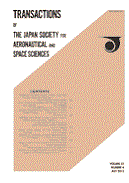
- Issue 6 Pages 217-
- Issue 5 Pages 171-
- Issue 4 Pages 147-
- Issue 3 Pages 123-
- Issue 2 Pages 71-
- Issue 1 Pages 1-
- |<
- <
- 1
- >
- >|
-
Yusuke ARAI, Hiroaki TANAKA, Masashi KASHITANI2025Volume 68Issue 6 Pages 217-223
Published: 2025
Released on J-STAGE: November 04, 2025
JOURNAL OPEN ACCESSTwist morphing wings require both high bending stiffness and low torsional stiffness. To address this challenge, lattice structures are investigated because they can achieve anisotropic properties by rearranging the lattice shape. We developed a twist morphing wing made from a periodic cubic lattice. Although flight testing was successful, a quantitative aerodynamic evaluation was needed. In this study, a cubic-lattice twist morphing wing was wind tunnel tested at 10 m/s and angles of attack from −4° to 20°. First, to investigate the wing’s fundamental aerodynamics, the non-morphed state was compared to a polystyrene wing. The results showed that, despite slight differences, the overall aerodynamic characteristics were similar and the twist morphing wing’s lift-to-drag ratio was higher. Next, the aerodynamic characteristics were examined on the morphing wing. Twisting the wings asymmetrically generated lift differences between the left and right wings, like an aileron. Symmetrical twisting provided a flapping functionality, altering the aerodynamic characteristics over a wide range at the same attack angle without changing the aircraft’s attitude. These results quantitatively demonstrate that twist morphing wings made from cubic lattices can achieve aerodynamic performance comparable to that of rigid wings while enabling flexible and efficient alteration of aerodynamic characteristics through wing twisting.
View full abstractDownload PDF (5607K) -
Yuta TAKAHASHI, Yoshiharu TANAHASHI, Tadashige IKEDA, Naoko KISHIMOTO, ...2025Volume 68Issue 6 Pages 224-231
Published: 2025
Released on J-STAGE: November 04, 2025
JOURNAL OPEN ACCESSAerodynamic characteristics of the black-tailed gull were investigated for two configurations in gentle and strong breezes. Firstly, the wing is twisted down, so the area of separation on the upper surface of the wing gradually expands and there is no sudden decrease in lift. Secondly, the crosswind characteristics change with the difference in shape. For flat wing configurations in gentle breeze, the rolling moment occurs such that the ventral side of the bird faces upwind, which can be called the dihedral effect for an upper-winged aircraft. While gull wing configurations in strong breeze, the rolling moment occurs such that the back side of the bird faces upwind, which can be called an active rolling control to keep flying straight. To confirm the flow around the wings, numerical analyses visualized the area where separations occurred. This study showed that by utilizing the 3D models of the bird, nondeformed models were analyzed to investigate the basic aerodynamic characteristics of the bird. In addition, by comparing the results with those of the experiments on the taxidermy bird, it will be possible to confirm the effects of the deflection of the wings and the surface texture, and to approach morphing technology from the bird.
View full abstractDownload PDF (10269K) -
Makoto ITO, Tsukasa FUNANE, Yosuke TANABE, Hisatoshi KIMURA, Koichi WA ...2025Volume 68Issue 6 Pages 232-241
Published: 2025
Released on J-STAGE: November 04, 2025
JOURNAL OPEN ACCESSThis paper describes a guidance system for efficient orbits of space solar power systems (SSPSs), with a particular focus on the use of quasi-geostationary Earth orbit (QGEO). SSPSs consist of a space solar power satellite and a ground site. The satellite collects solar energy in space and converts it into electromagnetic waves, then transmits the energy to the ground site on Earth. In general, the SSPS satellite is planned to be placed in geostationary Earth orbit (GEO), but this is highly challenging due to the limited space available in GEO since it is already occupied by satellites for telecommunications and Earth observation. Therefore, this paper describes the use of QGEO for SSPSs. We analyzed the received power on the ground site when the satellite is controlled in QGEO with a model of wireless power transfer and compared it with one controlled in GEO. Our findings showed that the received power under the QGEO condition with an inclination of 10 degrees and an eccentricity of 0.1, when the ground site was on the equator, was 6.8% higher than that under GEO condition. We conclude that the received power in QGEO is comparable to or higher than that in GEO.
View full abstractDownload PDF (5846K)
-
Kenichi SAKAMOTO, Yuichi ISHIDA, Takeharu SAKAI2025Volume 68Issue 6 Pages 242-245
Published: 2025
Released on J-STAGE: November 04, 2025
JOURNAL OPEN ACCESSDownload PDF (1587K)
-
2025Volume 68Issue 6 Pages 246
Published: 2025
Released on J-STAGE: November 04, 2025
JOURNAL OPEN ACCESSDownload PDF (28K) -
2025Volume 68Issue 6 Pages 247-248
Published: 2025
Released on J-STAGE: November 04, 2025
JOURNAL OPEN ACCESSDownload PDF (37K) -
2025Volume 68Issue 6 Pages 249
Published: 2025
Released on J-STAGE: November 04, 2025
JOURNAL OPEN ACCESSDownload PDF (23K)
- |<
- <
- 1
- >
- >|